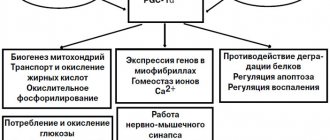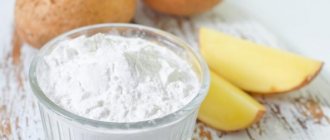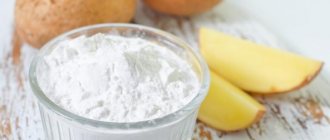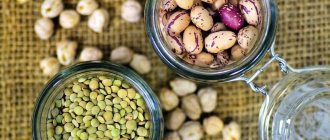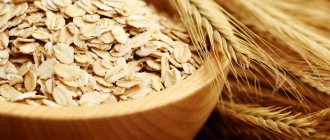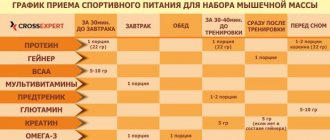Each muscle is made up of cells called muscle fibers (myofibrils). They are called “fibers” because these cells are highly elongated: with a length of several centimeters, their cross-section is only 0.05-0.11 mm. Let's say there are more than 1,000,000 of these fiber cells in the biceps! 10-50 myofibrils are collected in a muscle bundle with a common sheath, to which a common nerve (motoneuron) approaches. At his command, the bundle of fibers contracts or lengthens - these are the muscle movements that we make during training. And in everyday life, of course, too. Each bundle consists of fibers of the same type.
Slow muscle fibers
They are red or oxidizing, in sports terminology they are called “type I”. They are quite thin and well equipped with enzymes that allow them to obtain energy with the help of oxygen (hence the name “oxidative”). Please note that this way, by oxidizing, that is, burning, both fats and carbohydrates are converted into energy. These fibers are called “slow” because they contract by no more than 20% of the maximum, but they can work long and hard.
And “red” - because they contain a lot of myoglobin protein, which in name, functions and color is similar to blood hemoglobin.
What is connected with these muscle fibers. Long-term, uniform movement, endurance, weight loss, cardio and fat-burning workouts, slim, wiry figure.
Physiology of muscle activity
V. N. Seluyanov, V. A. Rybakov, M. P. Shestakov
Chapter 1. Models of body systems
1.1.4. Physiology of muscle activity
The biochemistry and physiology of muscle activity during physical work can be described as follows. Using simulation, we will show how physiological processes unfold in a muscle when performing a step test.
Let us assume that a muscle (for example, the quadriceps femoris muscle) has an MMV of 50%, the amplitude of the step is 5% of the maximum alactic power, the value of which is taken to be 100%, and the duration is 1 min. At the first step, due to low external resistance, low-threshold MUs (MUs) are recruited, according to Hanneman’s “size rule”. They have high oxidative capabilities; their substrate is fatty acids. However, for the first 10–20 s, energy supply comes from the reserves of ATP and CrP in active MFs. Already within one step (1 min.) the recruitment of new muscle fibers takes place, thanks to this it is possible to maintain the given power on the step. This is caused by a decrease in the concentration of phosphogens in active MVs, that is, the force (power) of contraction of these MVs, an increase in the activating influence of the central nervous system, and this leads to the involvement of new motor units (MUs). A gradual stepwise increase in external load (power) is accompanied by a proportional change in some indicators: heart rate, oxygen consumption, pulmonary ventilation increase, the concentration of lactic acid and hydrogen ions does not change.
When the external power reaches a certain value, a moment comes when all the IMF are involved in the work and the intermediate muscle fibers (IMF) begin to be recruited. Intermediate muscle fibers can be called those in which the mass of mitochondria is not enough to ensure a balance between the formation of pyruvate and its oxidation in the mitochondria. In the PMV, after a decrease in the concentration of phosphogens, glycolysis is activated, part of the pyruvate begins to be converted into lactic acid (more precisely, into lactate and hydrogen ions), which enters the blood and penetrates into the PMV. The entry of lactate into the IMF (OMV) leads to inhibition of fat oxidation; glycogen becomes the substrate of oxidation to a greater extent. Consequently, a sign of the recruitment of all MMVs (OMVs) is an increase in lactate concentration in the blood and increased pulmonary ventilation. Pulmonary ventilation increases due to the formation and accumulation of hydrogen ions in the PMV, which, when released into the blood, interact with the blood buffer systems and cause the formation of excess (non-metabolic) carbon dioxide. An increase in the concentration of carbon dioxide in the blood leads to increased respiration (Human Physiology, 1998).
Thus, when performing a step test, a phenomenon occurs that is commonly called the aerobic threshold (AeT). The appearance of AeP indicates the recruitment of all OMVs.
By the magnitude of external resistance, one can judge the strength of OMVs, which they can exhibit during the resynthesis of ATP and CrP due to oxidative phosphorylation (Seluyanov V.N. et al., 1991).
A further increase in power requires the recruitment of higher threshold MUs (HMUs), in which there are very few mitochondria. This enhances the processes of anaerobic glycolysis, and more lactate and H ions enter the blood. When lactate enters the OMV, it is converted back to pyruvate by the enzyme LDH H (Karlsson, 1971,1982). However, the power of the mitochondrial OMV system has a limit. Therefore, first there is a limiting dynamic equilibrium between the formation of lactate and its consumption in the OMV and PMV, and then the equilibrium is disturbed, and uncompensated metabolites - lactate, H, CO2 - cause a sharp intensification of physiological functions. Breathing is one of the most sensitive processes and reacts very actively. When blood passes through the lungs, depending on the phases of the respiratory cycle, it should have a different partial CO2 tension. A “portion” of arterial blood with a high CO2 content reaches chemoreceptors and directly modular chemosensitive structures of the central nervous system, which causes an intensification of respiration. As a result, CO2 begins to be washed out of the blood so that, as a result, the average concentration of carbon dioxide in the blood begins to decrease. When the power corresponding to AnP is reached, the rate of lactate release from the working glycolytic MVs is compared with the rate of its oxidation in the MVs. At this moment, only carbohydrates become the substrate of oxidation in the OM (lactate inhibits the oxidation of fats), some of them are glycogen from the OM, the other part is lactate formed in glycolytic MV. The use of carbohydrates as oxidation substrates ensures the maximum rate of energy production (ATP) in the mitochondria of the OMV. Consequently, oxygen consumption and/or power at the anaerobic threshold (AnT) characterizes the maximum oxidative potential (power) of OMV
(Seluyanov V.N. et al., 1991).
A further increase in external power necessitates the involvement of increasingly high-threshold motor units innervating glycolytic MVs. The dynamic balance is disrupted, the production of H and lactate begins to exceed the rate of their elimination. This is accompanied by a further increase in pulmonary ventilation, heart rate and oxygen consumption. After ANP, oxygen consumption is mainly related to the work of the respiratory muscles and myocardium. When pulmonary ventilation and heart rate limits are reached or when local muscle fatigue occurs, oxygen consumption stabilizes and then begins to decrease. At this moment, the MIC is recorded.
Thus, MIC is the sum of the oxygen consumption values of oxidative MVs (OMVs), respiratory muscles and myocardium.
| 1.1.1 | 1.1.2 | 1.1.3 | 1.1.4 | 1.1.5 | 1.1.6 | 2.1 | Table of contents |
Fast muscle fibers
Either white or glycolytic, they are called “type II”. They are noticeably larger in diameter than the previous ones, they have little myoglobin (that’s why they are “white”), but they have a large supply of carbohydrates and an abundance of so-called glycolytic enzymes - substances with the help of which the muscle extracts energy from carbohydrates without oxygen. This process, glycolysis, (hence the name “glycolytic”) produces a rapid and large release of energy.
These fibers can provide a powerful push, jerk, and sharp blow. Alas, the energy release will not be enough for a long time, so fast fibers do not work for long, they need to rest often. Strength training designed for them is therefore divided into several approaches: if you move continuously, the work is transferred to the slow fibers.
What is connected with these muscle fibers. Strength training, sprints, acceleration, muscular, pumped up figure, figure modeling, voluminous muscles.
General symptoms
The main symptoms of hyperkinesis include motor acts performed by patients against their will, the so-called violent ones. Patients themselves describe them as the result of an irresistible desire that they cannot resist.
The list of symptoms representing hyperkinesis includes:
- frequent blinking and squinting of the eyes (tics);
- convulsive tilting or turning of the head;
- tremor of various parts of the body, most often the limbs;
- myoclonus – sudden muscle twitching of the arms or neck;
- chorea - arrhythmic movements of facial expressions, involuntary sounds arising from rapid contractions of the muscles of the larynx;
- ballism - sudden rotation of the hip or shoulder;
- Blapharospasm is a pathological closure of the eyelids, as one of the signs of various diseases.
Forms of hyperkinesis can vary from intermittently frequent to constant. Some patients manage to control certain forms of hyperkinesis (for example, tics) by force of will, but after a while the attack of violent movements manifests itself again with even greater force.
Two types of fast muscle fibers
Yes, yes, not everything is so simple! Fast-twitch muscle fibers are also divided into two “divisions.”
Fast oxidative-glycolytic or intermediate fibers (subtype IIa) are fast (white) fibers, which nevertheless contain the same enzymes as slow ones. In other words, they can obtain energy both with and without oxygen. They are reduced by 25-40% of the maximum, and are “involved” in both strength training and weight loss exercises.
Fast non-oxidizing fibers (subtype IIb) are designed exclusively for short-term and very powerful efforts. They are thicker than all others and during strength training they increase more noticeably in cross-section than others, and contract by 40-100%. It is due to them that bodybuilders increase muscle volume, weightlifters and sprinters set records. But for fat-burning training they are useless. It is important that about 10% of muscle fibers (those fast intermediate ones - subtype IIa) can change their type.
If you often give your body a long-term load of moderate intensity (one that includes a maximum of slow-twitch fibers), then the intermediate ones will also adjust to the slow mode in a few months. If you focus on strength and sprint training, then both intermediate and even red fibers will approach fast fibers in their parameters.
How do hormones affect muscles?
As you already know, myosin is one of the main components of contractile muscle fibers, which accounts for about 40-60% of all skeletal muscles.
Biochemical analysis and immunohistochemistry of skeletal muscle helped determine that the structural and functional properties of muscle fibers depend mainly on isoforms . Therefore, in order to understand how hormones affect muscles, we first need to understand myosin, since it is it that primarily affects the speed and strength qualities of muscles.
The myosin molecule consists of 4 light chains (MyLC) and 2 heavy chains (MyHC). Heavy chains have a number of isoforms that determine muscle fiber strength and speed.
In an adult, the following main isoforms of MuNS :
- MyHCip
- MyHCIIA
- MyHCIIX/IID
- MuNSPV
Each of them is characterized by a certain degree of force and contraction speed . For example, fibers containing MyHCI have a low contraction speed and also weakly develop speed in comparison with MyHCIIA, IH and IIB. If we consider the fast muscle fibers MyNS, then the most powerful will be MyNSPV, then the fibers that contain MyNSIH and MyHCIIA.
How do hormones affect muscles?
Physical activity can significantly influence the contractile properties of muscles. For example, endurance work (running, swimming, skiing) increases the number of slow myosin isoforms. In turn, training in the gym increases MyHCIIA and at the same time decreases MyHCIIA fibers.
The training process affects skeletal muscles by changing hormonal levels , and this in turn gives a powerful impetus to changes in myosin isoforms, those muscle groups that are directly exposed to physical activity.
Effect of testosterone (steroids)
Experiments were carried out on animals that clearly showed how taking anabolic steroids increases the number of chains of slow myosin isoforms (study by Fritzshe et al., 1994; Czesla et al., 1997), it was also reported that taking in rodents increases MV with MyHCIIA chains and reduces with MyNSPPV, but at the same time there were cases when the portion of chains with MyHCIIA decreased in relation to MuNSPV (study by Kelly et al., 1985; Lyons et al., 1986; Salmons, 1992). All this indicates that anabolic steroids affect different types of muscle fiber differently.
Among other things, there is generally evidence that the use of anabolic steroids does not affect the ratio of MVs containing various MyHCI isoforms , for example, in the experiment, animals received intense exercise, the result of which was an increase in the content of slow MyHCI fibers, but further use of steroids did not affect the increase in heavy myosin chains (study by Boissonneault et al., 1987). Essentially the same thing happened in human , when some experienced weightlifters took anabolic steroids and others did not, as a result, scientists did not find a difference in the ratio of different MuHC isoforms in the trapezius muscle (study by Kadi et al., 1999b).
The effect of testosterone on muscles
Effect of estrogen
Scientific research (Greeves et al., 1999; Dionne et al., 2000; Meeuwsen et al., 2000) tells us that strength indicators inevitably decrease when menstrual cycles end, that is, from approximately 49 to 52 years .
If you remove the ovaries and look at what happens at the cellular level in the CF, we see a predominance of slow fibers in the myosin heavy chain and a decrease in fast running in mice (studies by Kadi et al., 2000). That is, the picture in relation to MuHC as a whole will look like this: MuHC I < IIA < IH < IV , which tells us that removal of the ovaries shifts the ratio of MuHC isoforms towards increasing slow isoforms and activation of genes for slow MuHC isoforms.
to run in the experiment , after which they were injected with estrogens , as a result of which it turned out that the composition of MuHC isoforms did not change. Scientists have concluded : the administration of estrogens during physical activity helps preserve red and white muscle fibers.
Effect of estrogen on muscles
Effect of growth hormone
According to a study by Lange et al., 2002, growth hormone stimulated an increase in MyNSIC chains in the vastus lateralis muscle in adult athletes, that is, the ratio of MyNS isoforms changed towards an increase in MuNSIC. The scientists concluded that somatotropin promoted the renewal of myosin heavy chains, since aging of these muscle groups usually contributes to a decrease in MyNSIC chains.
A study by Daugaard et al., 1999 tells us that people who were deficient in growth hormone had a greater proportion of MuNSIC than people who had enough growth hormone. Also in the same study it was said that treatment of a population with growth hormone deficiency with recombined samatropin for half a year did not cause any changes in the ratio of various MuHC isoforms.
Another study by Aroniadou-Anderjaska et al., 1996 in mice showed that the use of the hormone led to a significant thickening of fast muscle fibers in the soleus muscle, while the quantitative content of various isoforms in the MV remained at the same level . As a result, scientists came to a common opinion : additional research is required in order to determine the effect of taking growth hormone on the ratio of MuHC isoforms in the direction of increasing fast myosin isoforms.
Effect of growth hormone
Effect of thyroid hormones (T3)
According to a study by D'Albis and Butler-Browne back in 1993, thyroid hormones in skeletal muscle have a significant effect on the ratio of different isoforms of MyNS myosin. Another study by Larsson, Yu, 1997 showed that the regulation of muscle heavy chain ratio in mice depends on sex and muscle type. For example, after using the thyroid hormone T3 , in female and male individuals, an increase in MyHCIIA in the soleus muscle and a decrease in MyHCI were observed, and activation in the MyHCI muscles was only in male rats. floor.
The same study by Larsson, Yu, 1997 states that the use of triiodothyronine had no effect on the extensor toes longus muscles in male mice, but in female mice, on the contrary, there were significant changes in the ratio of MyHCIIA and IV isoforms.
Effect of thyroid hormones
Scientists have concluded that the contractile characteristics of muscles are influenced by hormonal levels and other growth factors that determine the properties of muscles in connection with their physiological needs. Therefore, the structure and function of certain muscle groups will directly depend not only on the ratio of hormones in the body, but also on gender and muscle type.
If you find an error, please select a piece of text and press Ctrl+Enter.
Muscle fibers: how to determine your type
Typically, a person has approximately 40% slow fibers and 60% fast fibers. Their exact number is determined genetically. Analyze your physique and perception of stress. As a rule, people who are naturally “wiry”, short in stature, with thin bones, who can easily walk, jog, ride a bike and other long-term activities, have a slightly higher percentage of slow and intermediate fibers.
And those who have wide bones, muscles easily grow even from small loads, but also the fat layer is added literally from one glance at cakes or pasta, are often “carriers” of some excess of fast-twitch fibers. If you know a person who, without really training, suddenly amazes everyone with his strength, you have a large number of fast, non-oxidative fibers. You can find tests online that offer to determine your predominant muscle fiber type. For example, doing an exercise with a weight of 80% of the maximum. If you completed less than 8 repetitions, your fast-twitch fibers predominate. More - slow.
In fact, this test is very conditional and speaks more about training in this particular exercise.
[new-page]
From theory to practice[edit | edit code]
The workout itself will look like this: warm-up with a weight of 35% of the expected RM; warm-up with a weight of 55% of the expected RM; rest for 3 minutes; an attempt to complete the exercise “at once” and find out your RM (if it is unknown); rest for 3 minutes; performing the movement to positive “failure” with a weight equal to 80% of the RM. After this, you can go home and analyze the results. If you managed to perform less than 8 repetitions in a set, then glycolytic fibers predominate in this muscle group. If you have completed 8-10 repetitions, then fiber equality is observed. Well, if you completed 11-12 repetitions, then you are the owner of predominantly oxidative fibers. Based on this data, you can build a training mesocycle. We have created the following.
MESO CYCLE DURATION: 5 WEEKS. IF GLYCOLYTIC FIBERS PREMIUMATE: 3 WEEKS OF LOW-REP STRENGTH TRAINING, 1 WEEK OF VOLUME TRAINING, 1 WEEK OF “PUMPING”. WITH AN EQUAL NUMBER OF FIBERS: 2 WEEKS OF STRENGTH AND VOLUME TRAINING, ONE WEEK OF PUMPING. IF OXIDATIVE FIBERS PREMIUMATE: 3 WEEKS OF VOLUME TRAINING, 1 WEEK OF STRENGTH TRAINING, 1 WEEK OF “PUMPING”.
In extreme cases (performed less than five or more than 15 repetitions), you can completely remove one of the phases (volumetric or force, respectively) and introduce them only in an even macrocycle. These are not the only possible combinations. You can easily create something for yourself or use well-proven schemes, such as: 4 weeks of specific training, 2 weeks of “the opposite”, after which everything is repeated again. This distribution of loads is based on the principle of specificity, which in the bodybuilding version says: “What you give a load, grows.” We are only deciding what type of load this load should be. Changing the training regime is necessary to overcome stagnation, as well as for completely objective reasons. For example, constant use of low-repetition training leads to a deterioration in muscle trophism; some capillaries simply close. To prevent this from happening, we do 12-15 repetitions per set. And vice versa - if you develop only the sarcoplasmic component, then your central nervous system will sooner or later forget how to send signals of sufficient strength.
Muscle Fibers: Exercise Selection
The names “fast” and “slow,” as you already understood, are not related to the absolute speed of your movements in training, but to the combination of speed and power. In this case, of course, muscle fibers are not involved in work in isolation: the main load falls on one type or another, and the other acts “in support”.
Remember: if you work with weights, the higher they are, the more actively the fast-twitch fibers are trained. If the weights are small, movements to train fast fibers should be sharper and more frequent. For example, jumping instead of squats, a 100-meter sprint instead of a leisurely cross-country, etc. But to train slow fibers, you need long, quiet workouts such as steady skating, walking, swimming, and calm dancing. Any acceleration and jerk will additionally connect fast fibers.
Causes of pathology
The main cause of hyperkinesis is dysfunction of the cerebral motor system. This disorder can be caused by various factors:
- degenerative processes in the central nervous system that are hereditary in nature;
- conditions associated with perinatal trauma;
- suffered traumatic brain injuries;
- brain tumors;
- various toxic lesions - alcoholism, CO2 poisoning;
- previous neuroinfections – meningitis, encephalitis;
- cerebrovascular accidents;
- endocrine diseases;
- psychogenic factors – neuroses, psychoses, anxiety disorders.
Hyperkinesis in some cases occurs as a side effect when taking psychostimulants or antipsychotics.
Muscle fibers: planning training
* If you need to add volume to a particular part of the body (say, pump up your arms, shoulders or hips), train mainly fast-twitch fibers in these areas by lifting weights and doing jumping jacks, push-ups, and pull-ups.
* If you want to get rid of excess fat, “load” slow fibers throughout your body. The best options for this are walking with poles, running, swimming or dancing.
* To further work on problem areas, add exercises on slow fibers: abduction-adduction of the leg, flexion, etc.
*For overall muscle tone, train both fiber types equally. Let's say, in the mode of a half-hour strength lesson and a half-hour cardio load after it 3-4 times a week.
By understanding what fast-twitch and slow-twitch muscle fibers are, you can tailor your workouts more effectively.
From strategy to tactics[edit | edit code]
NUMBER OF BARS LIFTED[edit | edit code]
Now let’s move from strategy to tactics, that is, we will discuss the methods of conducting a specific training session: rest time, time the muscle is under load, number of approaches, repetitions, etc. But before that, let’s introduce into consideration the term “number of barbells lifted,” also known as KPS . Strictly speaking, this term is from the dictionary of powerlifters, and its introduction into the “diet” of those involved in bodybuilding is somewhat artificial. However, not everyone can practice intuitively (this skill comes with experience), and some measure of training load must exist. For a long time, this role was played by weights and the number of repetitions, but we propose to introduce something new. You will soon understand the convenience of KPSh. From the name it is clear that we will be interested in the number of raised barbells (dumbbells, blocks - it doesn’t matter). We get this number by multiplying the approaches done by the repetitions. It is important that in this article the numbers in the KPS column also take into account warm-up approaches. Another advantage of this term is that it gives greater (with emphasis on the first syllable) flexibility in load planning. Let me give you an example. You need to apply a load with a KPS equal to 55. You know that you will have to work in the range of 10 repetitions per set. You automatically get 5 approaches. This is an example of strict planning. Another example: you have a CPS of 60, and then, based on your experience, you work at least in the 6x10 mode (6 sets of 10 repetitions), at least 10x6, at least 15x4...
STRENGTH TRAINING[edit | edit code]
The time the muscle is under load is 5-15 s, which gives us 3-8 repetitions per set. Rest time between approaches is up to 2-4 minutes (until the level of creatine phosphate in the muscles is completely restored) Number of approaches 5-8 KPS: 25-45 The exercises are not performed to failure. “Failure” is possible only in the last repetition of the last approach. Number of exercises: 1-2
VOLUMETRIC TRAINING[edit | edit code]
The time the muscle is under load is 25-35 s, which gives us 11-16 repetitions per set. Rest time between approaches is up to 2-3 minutes. Number of approaches is 6-9 KPSh-66-80. Exercises are performed almost to failure. Number of exercises. : 2-4 For the basic exercise, use the ascending pyramid method. Next come the formative movements.
“PUMPING”[edit | edit code]
The time the muscle is under load is 60-90 s, which gives us 25-40 repetitions per set. The rest time between approaches is minimal. Number of approaches: 10-15 KPS: 250-350 Each approach is performed until positive muscle “failure”. But this must be a “failure” of the target muscle, and not the nervous or respiratory system. Number of exercises - 3-5 Let us once again note the advantages of this approach. By playing KPS within given boundaries, as well as the length of macrocycles, you can create and conduct an infinitely large number of training sessions. You do the exercises in the mode that best suits your body. After all, the body itself told you what is best for it! Of course, training is not everything. We remind you of the need to monitor two other “whales”: nutrition and recovery. Only with an integrated approach will you achieve high results.
Source Iron World No. 2
